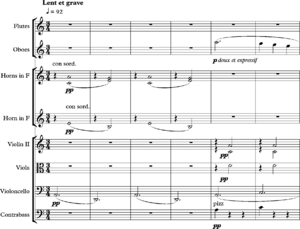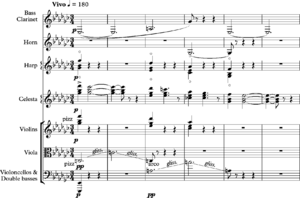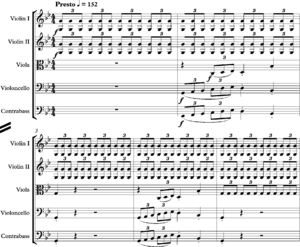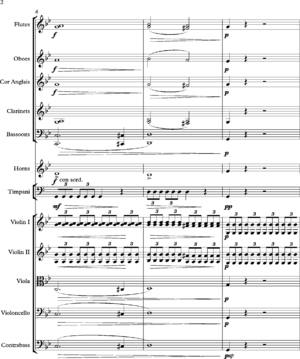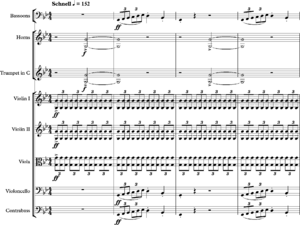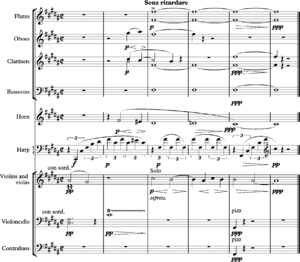Arrangement facts for kids

In music, an arrangement is like giving an existing song or piece of music a makeover. It's when a composer or musician takes a piece that already exists and changes it to be played in a new way. This might mean changing the chords, making the melody a bit different, deciding which instruments play which parts (this is called orchestration), or even changing the overall structure of the song.
Arranging is different from just orchestration. Orchestration is only about choosing which instruments play the notes for an orchestra or band. Arranging goes further. It can add new parts, like an intro, bridges between sections, or a new ending. It's all about making an existing tune sound fresh and interesting. In jazz, a special kind of arrangement that isn't written down but remembered by the musicians is called a head arrangement.
Contents
Classical Music Arrangements
Arranging and transcribing (which means writing music down for different instruments) have been part of classical and serious music for a very long time.
Famous Classical Arrangements
Many famous composers have arranged their own music or the music of others.
Bach's Arrangements
J.S. Bach often rearranged his own pieces. For example, he took a fast solo violin piece called the Prelude from his Partita No. 3.
Bach then turned this solo violin piece into a full orchestral Sinfonia for his Cantata BWV29. He even changed the key from E major to D major to make it easier for the wind instruments to play. It's amazing how he made a piece for one instrument sound so good for a whole orchestra!
Piano Music Arrangements
Music written for the piano has often been arranged for other groups of instruments, like an orchestra or a concert band. For instance, Beethoven arranged one of his piano sonatas for a string quartet. He also took a difficult piece for string quartet, his Grosse Fuge, and arranged it for two pianos to play together.
Sometimes, a composer might need help with arranging. The American composer George Gershwin had his famous Rhapsody in Blue arranged and orchestrated by Ferde Grofé because Gershwin wasn't an expert in writing for a full orchestra.
Erik Satie wrote three piano pieces called Gymnopédies in 1888.
Years later, Debussy arranged two of them for orchestra. He used the different sounds of the orchestra's instruments to make them sound richer. Debussy's arrangements actually helped make Satie's music more famous!
Pictures at an Exhibition is a well-known set of ten piano pieces by Modest Mussorgsky. It has been arranged over twenty times! The most famous arrangement is by Maurice Ravel. Ravel was very good at creating unique and memorable sounds with an orchestra.
Ravel's arrangement of "Gnomus" shows how he could make the same musical idea sound different each time. He would change which instruments played the notes, creating new colors and textures.
Then, he would repeat the same part but use different instruments, like a celesta (a keyboard instrument that sounds like bells) and strings, to give it a fresh sound.
Arrangements of Songs
Many songs, especially those originally for a singer with piano, have been arranged by other composers. For example, Franz Schubert's intense song Erlkönig (The Erl King) has a piano introduction that sounds very urgent.
Hector Berlioz arranged this song for orchestra. He used strings to keep the driving, threatening feeling of the original.
Berlioz also added more instruments like woodwinds, horns, and timpani to add color. He even changed some of the chords to make them sound more dramatic.
Franz Liszt also arranged Erlkönig. His version sounds a bit different from Berlioz's. Liszt used more violins and violas playing together to make the string sound thicker. He didn't change the harmonies as much as Berlioz, but he changed the emphasis of certain notes.
Gustav Mahler's Lieder eines fahrenden Gesellen (Songs of a Wayfarer) were first written for voice and piano. Mahler later arranged them for orchestra himself. He was very good at making sure each instrument's part was clear and sounded good.
In his orchestral arrangement, Mahler carefully chose instruments like woodwinds, strings, and horn to create different musical colors. He used a harp to play the flowing arpeggios that the piano originally played. He also gave a special melody to the horn that was only hinted at in the piano version.
Popular Music Arrangements
In pop music, recordings often include parts for brass sections, strings, and other instruments. These parts are usually added by arrangers, not the original songwriters. Sometimes, pop arrangers even use a full orchestra, though this is less common because it can be expensive.
Pop music arrangements can also be new versions of old songs with a fresh musical style. This might involve changing the tempo (speed), rhythm, key, or instruments used.
Some famous examples include Joe Cocker's version of the Beatles' "With a Little Help from My Friends," Cream's "Crossroads", and Ike and Tina Turner's version of Creedence Clearwater Revival's "Proud Mary". Bands like Vanilla Fudge and Yes became known for taking popular songs and completely rearranging them in their own unique styles. Remixes in dance music are also a type of arrangement.
Jazz Arrangements
For small jazz groups, arrangements are often informal and not written down. However, larger groups like big bands usually need written arrangements. The early Count Basie big band was famous for its head arrangements. These were worked out by the musicians together, memorized, and never written down. Most big band arrangements, though, are written down and credited to a specific arranger, like Sammy Nestico and Neal Hefti for Count Basie's later bands.
Don Redman was a pioneer in jazz arranging in the 1920s with Fletcher Henderson's orchestra. His arrangements made the melodies more complex and gave different sections of the big band their own special parts. Benny Carter later became Henderson's main arranger. Jelly Roll Morton is sometimes considered the first jazz arranger. He wrote down parts for his compositions so that different bands could play them.
Big-band arrangements are often called charts. In the swing era, they were usually arrangements of popular songs or brand new compositions. After the bop era, it became more common to arrange simpler jazz combo pieces for big bands.
After 1950, big bands became less common. However, many bands continued, and arrangers like Gil Evans, Nelson Riddle, and Henry Mancini created famous arrangements. In the 21st century, big band arrangements are making a comeback, with new bands like those led by Gordon Goodwin and Christian McBride playing both original music and new arrangements of classic tunes.
See also
 In Spanish: Arreglo (música) para niños
In Spanish: Arreglo (música) para niños
- Transcription (music)
- Instrumentation (music)
- Orchestration
- Reduction (music)
- Musical notation
- American Society of Music Arrangers and Composers
- Electronic keyboard (or Electronic Music Arranger), which allows for live music arrangement
- List of music arrangers
- List of jazz arrangers
- Category:Music arrangers




